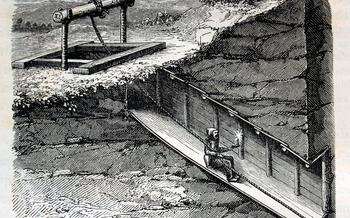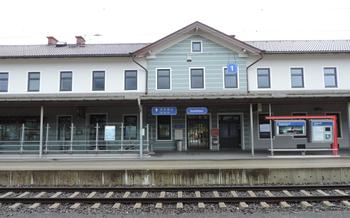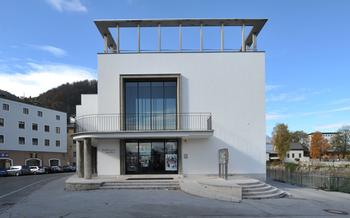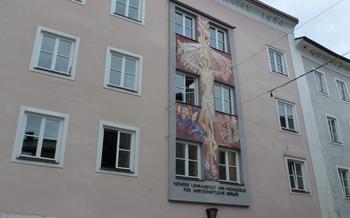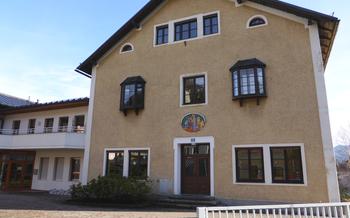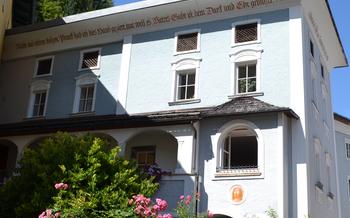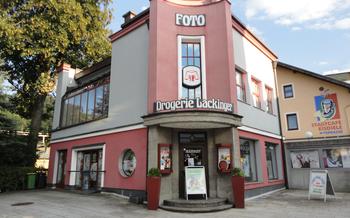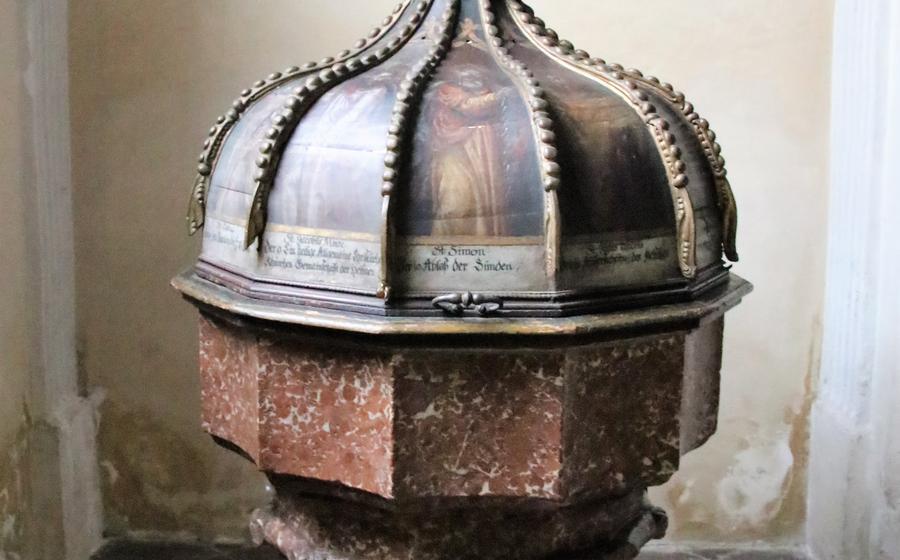
Hallein Salt Mine
- Hallein Salt Mine: A Journey into the Underworld
- Descent into the Mine: Embracing Darkness
- The Hallstatt Era: Unearthing Ancient Treasures
- The Celts: Ancient Salt Miners
- The Romans: Engineering and Efficiency
- The Middle Ages: A Time of Expansion
- The Renaissance: Art and Science Meet Mining
- The Baroque Era: Splendor and Opulence
- The 19th Century: Industrialization and Modernization
- The 20th Century: War, Recovery, and Tourism
- The Salt Chambers: A Realm of Natural Wonders
- The Salt Miners: Guardians of the Underworld
- The Salt Museum: Unlocking the Secrets of Salt
- The Sound of Music Cave: A Musical Underground
- Insider Tip: Explore the Hidden Corners
Hallein Salt Mine: A Journey into the Underworld
History of the Mine
For over 2,500 years, the Hallein Salt Mine has been a hub of activity, shaping the cultural, historical, and economic landscape of the region. The mine's rich history dates back to the pre-Celtic era, when ancient miners ventured into the depths of the Dürrnberg Mountain to extract the precious mineral that would become a linchpin of civilization. Over the centuries, the mine has been shaped by diverse civilizations, each leaving their mark on its subterranean labyrinth.
Location and Accessibility
Nestled in the picturesque town of Hallein, just south of Salzburg, the Hallein Salt Mine is easily accessible by car or public transport. The entrance to this subterranean realm is a mere 20-minute walk from Hallein train station, inviting visitors to embark on a journey into the heart of the mountain.
Guided Tours and Ticket Prices
To fully immerse yourself in the mine's captivating history and geology, guided tours are highly recommended. Experienced guides lead visitors through the labyrinthine tunnels, sharing stories, legends, and scientific insights that bring the mine's past to life. Ticket prices vary depending on the type of tour and any additional attractions included.
What to Expect During the Tour
Prepare for an awe-inspiring journey into a world of salt and shadow. As you descend into the mine, the temperature drops, and the air becomes heavy with the unique scent of salt. Marvel at the intricate network of tunnels, carved over millennia by the hands of tireless miners. Discover hidden chambers, witness stunning salt formations, and experience the unique acoustics of the underground world.
Descent into the Mine: Embracing Darkness
Prepare for a journey into the unknown as you embark on a ride aboard the miners' train, venturing deep into the heart of the Hallein Salt Mine. The train chugs along narrow tracks, taking you through dimly lit tunnels that seem to stretch endlessly. The air becomes cool and damp, carrying the faint scent of salt and minerals. As you descend further, the darkness envelops you, creating a sense of awe and mystery.
The train comes to a halt, and you step out onto a wooden platform, surrounded by towering walls of salt. The flickering light of lanterns casts eerie shadows on the rough-hewn surfaces, revealing the intricate patterns and textures of the salt formations. The silence is broken only by the gentle dripping of water and the distant rumble of machinery.
Your guide leads you through a labyrinth of tunnels, each one narrower and more challenging than the last. You duck and weave, following the guide's flashlight beam, always mindful of the low ceilings and uneven ground. The darkness becomes so intense that you can almost feel it pressing against your skin.
Suddenly, the tunnel opens up into a vast chamber, and you are greeted by a breathtaking sight. A shimmering underground lake reflects the flickering lights, creating a surreal and magical atmosphere. Salt crystals sparkle like diamonds, adorning the walls and ceiling, forming intricate patterns that seem to dance in the dim light. This is a realm of natural wonders, where the darkness gives way to a subterranean paradise of salt formations and crystal structures.
The Hallstatt Era: Unearthing Ancient Treasures
In 1846, workers in the Hallein Salt Mine stumbled upon a remarkable discovery: a prehistoric salt mine dating back to the Hallstatt era, around 800 BC. This discovery revolutionized our understanding of ancient mining practices and shed light on the significance of salt in prehistoric societies.
The Hallstatt salt mine is named after the nearby town of Hallstatt, which became a prominent center for salt production during the Iron Age. Artifacts found in the mine, such as tools, pottery, and jewelry, provide valuable insights into the lives and culture of the Hallstatt people. These artifacts suggest that the Hallstatt miners were highly skilled and organized, using advanced mining techniques to extract salt from the underground chambers.
The connection between the Hallein Salt Mine and modern-day Hallstatt is a testament to the enduring legacy of salt mining in the region. Hallstatt, with its picturesque lakeside setting and well-preserved prehistoric sites, has become a popular tourist destination, attracting visitors interested in exploring the region's rich history and cultural heritage.
The Celts: Ancient Salt Miners
The Celts, an enigmatic and influential people, played a pivotal role in the development of salt mining in the Hallein region. Their mastery of metalworking and engineering techniques enabled them to devise innovative mining methods, transforming the salt industry and leaving a lasting legacy.
Skilled miners, the Celts employed a range of techniques to extract salt from the earth. They constructed intricate networks of tunnels and shafts, delving deep into the underground labyrinth. Their use of bronze and iron tools allowed them to cut through the hard rock and extract large quantities of salt.
Salt held immense cultural and economic significance for the Celts. It was not merely a seasoning but a valuable commodity, used for preserving food, trading, and even as a form of currency. The control of salt mines brought wealth and power, making them fiercely protective of their mining operations.
Numerous Celtic artifacts discovered in the mine provide glimpses into their mining practices and beliefs. These include tools such as picks, axes, and chisels, as well as votive offerings and religious objects, suggesting that the Celts revered the salt mine as a sacred place.
The Celts' contributions to salt mining in Hallein laid the foundation for future developments and shaped the region's mining heritage. Their ingenuity and expertise left an indelible mark on the history of the salt mine, ensuring its continued importance for centuries to come.
The Romans: Engineering and Efficiency
The Romans, known for their engineering prowess, brought significant advancements to salt mining techniques in Hallein. They introduced new methods that increased efficiency and productivity, leaving a lasting legacy in the mine's development.
One of the most notable Roman innovations was the construction of an extensive network of tunnels and galleries, which allowed for better access to the salt deposits and facilitated the transportation of materials and workers. They also implemented a system of water management to control flooding and ensure the safety of the miners.
The Romans were the first to use wooden props and beams to support the mine's structure, preventing cave-ins and ensuring the stability of the underground workings. This innovation greatly improved the safety of the mine and allowed for deeper excavations.
Furthermore, the Romans introduced the use of bronze and iron tools, which were more durable and efficient than the tools previously used by the Celts. These tools enabled the miners to extract salt more quickly and efficiently, increasing the overall productivity of the mine.
The legacy of Roman engineering is still evident in the Hallein Salt Mine today. The network of tunnels and galleries they constructed, along with the water management system and the use of support beams, have ensured the mine's longevity and safety. Visitors can still see remnants of Roman mining techniques and artifacts, providing a glimpse into the ingenuity and innovation of the ancient Romans.
The Middle Ages: A Time of Expansion
During the Middle Ages, the salt industry in the Hallein Salt Mine experienced significant growth and expansion. The demand for salt increased as populations grew and trade routes expanded. This led to the development of new mining techniques and technologies to meet the growing demand.
One of the most important innovations of this period was the introduction of the waterwheel. Waterwheels were used to power pumps that removed water from the mine, allowing miners to access deeper levels of salt deposits. The use of waterwheels also enabled the mine to operate more efficiently and productively.
Another important development during the Middle Ages was the expansion of the mine's infrastructure. New shafts and tunnels were dug, and the mine was connected to nearby towns and cities by a network of roads and waterways. This allowed for the efficient transportation of salt and other goods, further contributing to the growth of the salt industry.
The economic importance of salt during the Middle Ages cannot be overstated. Salt was essential for preserving food, and it was also used in a variety of industrial processes. As a result, salt was a valuable commodity, and the Hallein Salt Mine played a crucial role in meeting the demand for this vital resource.
The Renaissance: Art and Science Meet Mining
During the Renaissance, a period marked by cultural and scientific advancements, the Hallein Salt Mine was influenced by the prevailing intellectual and artistic currents. Mining techniques were refined, incorporating new ideas and technologies. Artists depicted the world of salt mining in their works, capturing the essence of this subterranean realm.
One of the most notable figures of the Renaissance, Leonardo da Vinci, displayed a keen interest in the salt mine. He conducted extensive studies of the mine's geology and mining methods, seeking to understand the natural processes at work and the techniques employed by the miners. His observations and drawings provide valuable insights into the mining practices of the time.
The Renaissance also witnessed a renewed emphasis on education and scientific inquiry. This intellectual curiosity extended to the field of mining, leading to the development of new mining technologies and techniques. The introduction of improved tools and equipment enhanced the efficiency and safety of mining operations.
Overall, the Renaissance was a period of significant transformation for the Hallein Salt Mine, characterized by the integration of art, science, and technology. These developments laid the foundation for the mine's continued growth and prosperity in the centuries that followed.
The Baroque Era: Splendor and Opulence
The Baroque era, known for its extravagance and grandeur, left a lasting impression on the Hallein Salt Mine. During this period, the mine experienced a surge in artistic and architectural embellishments. Elaborate carvings and sculptures adorned the walls and chambers, showcasing the skills of master craftsmen. These intricate works of art depicted scenes from mythology, religion, and the daily lives of the miners. The Baroque influence also extended to the mine's infrastructure, with the construction of grand staircases, vaulted ceilings, and ornate doorways. These architectural marvels not only enhanced the aesthetic appeal of the mine but also reflected the importance and prosperity of the salt industry during this time. The Baroque legacy continues to captivate visitors, who marvel at the splendor and artistry that permeate the underground world of the Hallein Salt Mine. The Baroque era transformed the mine into a subterranean masterpiece, showcasing the convergence of art, science, and mining.
The 19th Century: Industrialization and Modernization
The 19th century marked a period of significant transformation in the Hallein Salt Mine, as it embraced industrialization and modernization. The introduction of modern machinery and technology revolutionized mining operations, leading to increased efficiency and productivity. New mining methods and techniques were developed, such as the use of explosives and mechanized drilling, which allowed for deeper and more efficient extraction of salt. These advancements not only enhanced the mine's output but also improved the safety and working conditions for the miners. The industrialization of the salt mine had a profound impact on the local economy, contributing to its growth and prosperity. It also attracted skilled workers from various regions, fostering a diverse and vibrant mining community.
The 20th Century: War, Recovery, and Tourism
The 20th century brought both challenges and opportunities for the Hallein Salt Mine. During World War I and World War II, salt mining operations were disrupted, and the mine suffered damage. However, in the post-war period, there was a concerted effort to rebuild and recover. The mine was modernized and expanded, with the introduction of modern machinery and technology. These advancements increased efficiency and productivity, allowing the mine to continue operating as a viable enterprise.
In the latter half of the 20th century, tourism emerged as a new and important industry for the Hallein Salt Mine. With its unique historical and geological features, the mine became a popular destination for visitors from around the world. Guided tours were developed, and the mine was transformed into a fascinating tourist attraction. Today, the Hallein Salt Mine is one of the most visited tourist attractions in Austria, attracting hundreds of thousands of visitors each year.
The Salt Chambers: A Realm of Natural Wonders
Descending into the heart of the Hallein Salt Mine reveals a subterranean wonderland of natural marvels. The salt chambers, carved by centuries of mining activity, showcase stunning salt formations and crystal structures that shimmer and sparkle in the dim light. Underground lakes and waterfalls add to the ethereal atmosphere, creating a sense of awe and wonder. The acoustics within the chambers are equally remarkable, with natural echoes and reverberations that create a unique soundscape. Light effects, carefully designed to illuminate the salt crystals, enhance the visual spectacle, transforming the chambers into a magical realm. Visitors can marvel at the beauty of these natural wonders, gaining a deep appreciation for the geological processes that have shaped this subterranean masterpiece.
The Salt Miners: Guardians of the Underworld
Deep within the heart of the Hallein Salt Mine, a resilient community of salt miners has toiled for centuries, extracting the precious mineral from the earth's depths. These men and women, known as Knappen, have a rich history and tradition that is deeply intertwined with the mine itself.
The Knappen faced numerous challenges and hazards in their daily work. The darkness, humidity, and cramped conditions of the mine were constant companions. The risk of cave-ins, rockfalls, and flooding was ever-present. Despite these dangers, the Knappen displayed remarkable courage and resilience, working together to overcome obstacles and ensure the safety of themselves and their colleagues.
Camaraderie and community were essential to the Knappen. They relied on each other for support and assistance, both inside and outside the mine. A strong sense of brotherhood developed among them, born out of shared experiences and a common purpose. This camaraderie extended beyond the workplace, with the Knappen often socializing and celebrating together outside of work hours.
The Knappen played a vital role in preserving the mine's heritage and traditions. They passed down their knowledge and skills from generation to generation, ensuring that the techniques and practices of salt mining were maintained. They also played a crucial role in maintaining the mine's infrastructure, ensuring that it remained safe and operational for future generations.
The Salt Museum: Unlocking the Secrets of Salt
Nestled within the heart of the Hallein Salt Mine lies a treasure trove of knowledge and history—the Salt Museum. This fascinating museum invites visitors to delve into the captivating world of salt mining, revealing the secrets and stories that have shaped this remarkable underground realm.
Through interactive exhibits and captivating displays, the museum unveils the rich tapestry of the mine's past. Visitors can trace the evolution of mining techniques from ancient times to the present day, marveling at the ingenuity and determination of the salt miners who toiled in these depths.
Artifacts and tools used by miners throughout the centuries are showcased, providing a tangible connection to the lives and labors of these subterranean explorers. From simple hand-held implements to sophisticated machinery, these relics offer a glimpse into the challenges and triumphs of salt mining.
Interactive exhibits bring the history of the mine to life, allowing visitors to experience the sights, sounds, and sensations of a working salt mine. Hands-on activities and multimedia presentations engage visitors of all ages, making learning about salt mining a truly immersive and memorable experience.
The Salt Museum is not just a repository of historical artifacts; it is a place where the spirit of the salt miners lives on. Through its exhibits and displays, the museum pays tribute to the generations of men and women who dedicated their lives to extracting this precious resource from the earth, shaping the history and culture of the region.
The Sound of Music Cave: A Musical Underground
Deep within the Hallein Salt Mine lies a hidden gem that echoes with the melodies of music – the Sound of Music Cave. Discovered during the filming of the iconic movie "The Sound of Music," the cave possesses an enchanting acoustic quality that transforms it into a natural concert hall. Its unique geological formations and high ceilings create a reverberation that enhances the sound of music, making it an ideal venue for concerts and performances.
Throughout the year, the Sound of Music Cave hosts a variety of musical events, ranging from classical concerts to folk music performances. Visitors can experience the magic of music as it resonates through the cave's chambers, creating an immersive and unforgettable experience. The acoustics of the cave have also attracted choirs and musicians from around the world, who come to perform in this unique setting.
For those seeking a truly special musical experience, the Sound of Music Cave offers a rare opportunity to witness the power of sound in a subterranean realm. As the melodies echo through the cave, visitors are transported to a world where music and nature converge, creating a symphony that resonates long after the performance ends.
Insider Tip: Explore the Hidden Corners
For a truly immersive and unforgettable experience, venture off the beaten path to discover the hidden corners of the Hallein Salt Mine. While the main tour routes offer a comprehensive overview, there's a whole world of secrets waiting to be uncovered beyond the well-trodden paths.
Seek out hidden chambers and secret passages that lead to forgotten corners of the mine. These hidden gems often reveal unique formations, historic artifacts, and intriguing stories that bring the mine's rich past to life. Along the way, you'll feel like a true explorer, uncovering the secrets of this subterranean world.
As you delve deeper into the mine, you'll gain a deeper appreciation for the ingenuity and perseverance of the miners who worked here for centuries. Their legacy lives on in every hidden corner, waiting to be discovered by curious and adventurous souls.
So, embrace your inner explorer and embark on a journey of discovery. Let the salt mine's hidden corners reveal their secrets, and create your own unique adventure that will stay with you long after you've left this fascinating underground world.
